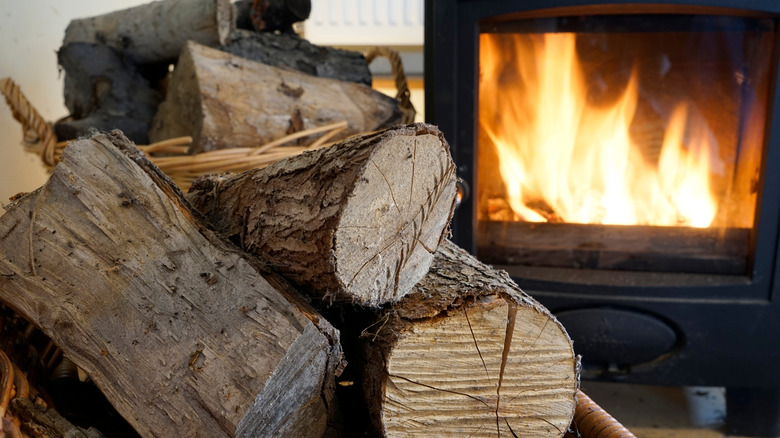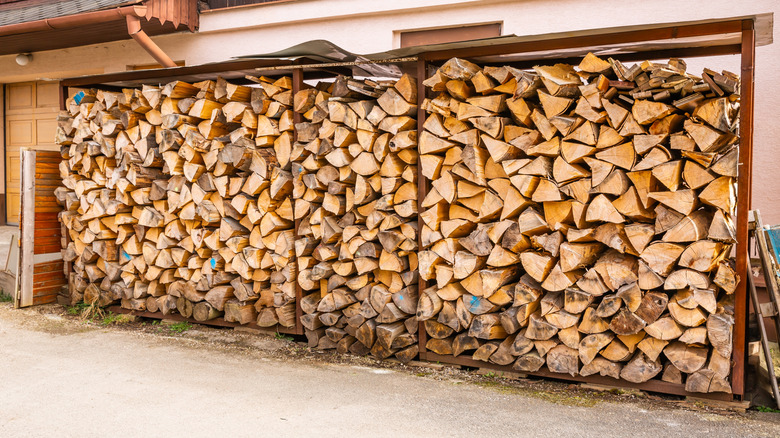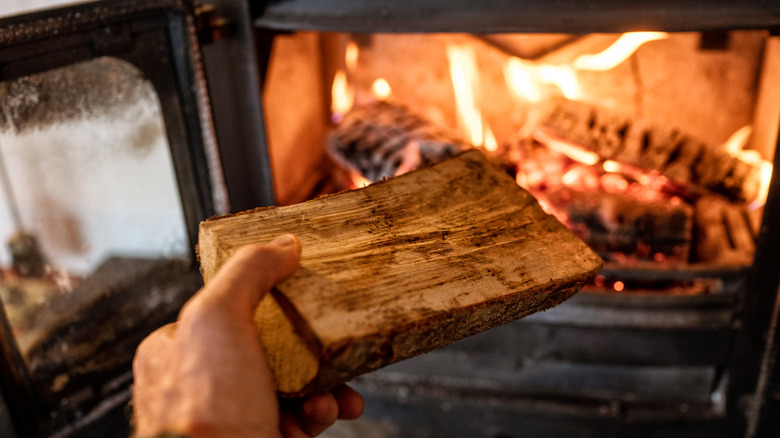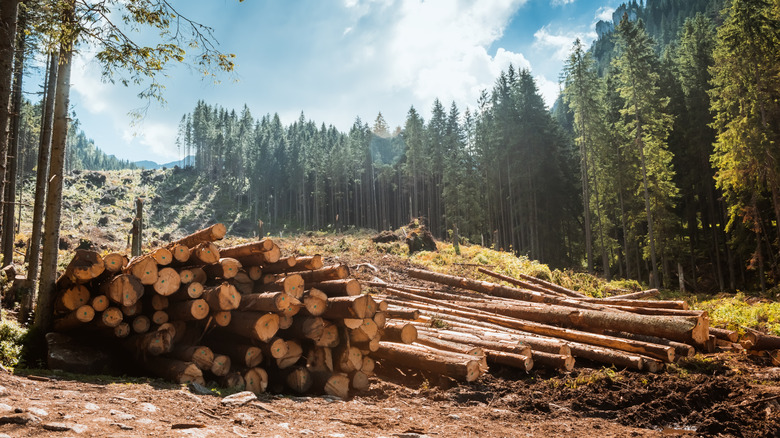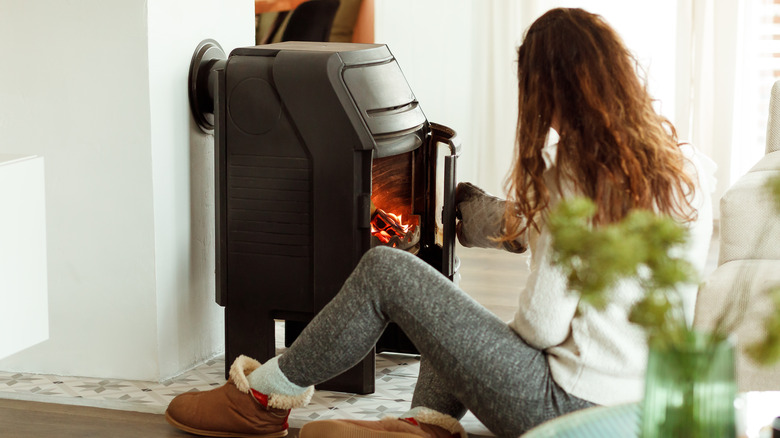Burning Pine In Your Woodstove Is Totally Fine (So Don't Be A Snob About It)
There might be no more reliable path to picking a fight than unorthodoxy. If your goal is to get drubbed in a bar fight, excommunicated, divorced, or disowned, then the approach of sneering at something everyone has believed since childhood makes for a pretty good strategy. And if your goal is to get yourself ridiculed by wood stove installers and old-timers, just say the following words: "It's perfectly okay to burn pine in a modern wood stove."
Oof. Well, now you've gone and done it. They're going to auction off your poker and rehome your firedogs... never mind that you're completely right.
The word that you're about to hear repeated over and over, in these arguments, is creosote: It's an encrustation of incompletely burned particles on the inside of your stove chimney that can, under the right circumstances, catch fire (and in the wrong circumstances, burn down your house). The argument that burning pine causes more creosote has been the orthodox point of view for so long that these two things are inextricably linked in some people's minds. This notion, surprisingly, doesn't appear to be particularly true. All wood can produce creosote, but if you're burning it right, you won't produce enough to fret over. The actual issues when it comes to creosote production are green wood, outdated stoves, and inflexible viewpoints.
Hold your frenetically typing fingers. Before you start emailing me about this, hang on long enough to see what the scientists have to say. And yes, of course, there are other reasons to choose hardwoods over pine — as pine, being less dense, burns faster. That said, the facts surrounding this issue, while complex, are surprisingly cut and dry.
As long as your pine is dry, you'll get a nice, hot, safe burn — just avoid green wood
The trinity of orthodox beliefs about avoiding creosote are (1) that you should only burn hardwood, (2) burn it dry, and (3) burn it hot. Those last two points are closely related, and while "hot" is the truly operative word, "dry" seems to be the best way to get there. Conventional wisdom says that wet (unseasoned) wood will produce creosote, but dry wood burns hotter and will only produce negligible amounts. Why this works is the key to understanding why, in fact, "pine is fine," as us heretics like to say on wood stove forums.
Experts dislike wet wood for two reasons. First, the evaporation of water (as much as 50 percent of green wood's weight) absorbs heat, so that your wet firewood can't burn as hot as it would with seasoned wood. Second, since it's not as hot, when the gasses enter a stovepipe and hit the dew point, the water (and other gasses) condense on the inside of the pipe. The wetness makes the smoke particles stick better. The way around this is to burn dry wood, which has less than 20 percent water content, and closer to 10 percent whenever possible.
So, long story short, if you have green wood? You should split it, and season that firewood for 6-12 months before chucking it in your wood stove. What doesn't matter, in terms of safety or creosote, is whether your stack of seasoned wood is pine or something harder. Hardwood, softwood — it doesn't matter as long as it's dry — and if you burn seasoned, bone-dry pine, it's automatically guaranteed to burn hot.
The age-old myth that hardwood burns hotter than pine? Not true
However, does hardwood burn hotter than pine? If you google it, you'll quickly learn that it does. Experts, AI bots, and snobby wood stove salespeople all agree that it does, and they all appear to be mistaken. The best research on the topic actually comes from a high school teacher who did a pretty unimpeachable study that shows, as other research has, that pine burns as hot as — and maybe a bit hotter than — poplar and oak.
The common claim that hardwood burns hotter is probably the result of the fact that hardwood produces more BTUs, which it does by burning longer, not necessarily hotter. This is an artifact of measuring firewood by volume rather than weight and mass. Hardwoods (or, more accurately, denser woods) generally produce more heat energy, but not always by pound. If you compare the BTU output of dry red oak versus dry lodgepole pine, for example, you'll find that the pine produces less energy by volume but about 15.8% more BTUs per pound of wood.
Now, here's where we get to the argument for hardwood over softwood, but it's not about creosote or safety — just longevity. Because pine is a hotter and faster burn, it's probably not the ideal option if you're trying to load up the stove for overnight warmth. That said, doing this latter approach — presuming you're closing the damper to create a low flame that coolly burns throughout your dozing hours — is itself going to create creosote, even if it's red oak.
Ignore outdated advice on pine: Newer stoves burn better
Creosote is produced by colder fires, and the incomplete combustion that results. To make fires as hot as possible, you can't do much better than a modern, EPA-certified wood stove. They're as much as 50 percent more efficient than older models, four times as efficient as an old open fireplace, and can use ⅓ less wood, which translates to less creosote. Modern stoves, especially catalytic models, produce more heat more efficiently. They burn longer, hotter, and cleaner ... and cleaner means up to 70 percent less un-combusted creosote and pollutants, so you can sweep the creosote from your chimney once a year rather than every couple of months.
Burning seasoned hardwood in a modern wood stove works for the same reason that burning seasoned pine in the same stove also works. Julian Beckwith, Extension Service wood products specialist with the D.B. Warnell School of Forest Resources at the University of Georgia, says that people get the impression that pine resins contribute to creosote buildup, but the hot fires produced in a properly operated (and even more importantly, an efficient and modern) wood stove will practically eliminate the creosote problem for any dry wood. As he puts it, "Creosote buildup on fireplace or wood-heater walls, chimneys and flue pipes, seems more a result of burning wood at relatively low temperatures."
Now, it's time to get into the fun science part of why pine is fine — and how it may challenge all of our assumptions.
Pine is fine, and your wood stove will burn it up happily
The science — most of which is from the late seventies and early eighties, when wood stoves became all the rage and firewood did about 10 percent of our heating — backs up Julian Beckwith's claim. The Auburn Wood Burning Laboratory's 1979 research and a 1982 Georgia Forestry Commission research project both found that pine — get ready for this — actually produces less creosote than oak and other hardwoods.
However, both studies also included other anomalous findings, including that dry firewood produces more creosote than unseasoned wood. The Auburn study used wood that was selected by its geometry and volume, not mass. The same Auburn study found that dry wood produces more creosote than unseasoned wood. There are a few possible reasons this finding could have occurred, but it probably boils down, no pun intended, to the fact that the study burned wood more carefully and efficiently than homeowners could in the late 1970s, so the moisture and resin content became far less relevant — just as they have for our far more efficient modern wood stoves. What we should focus on instead, then, is that it's now common knowledge among experts that low fires, not sap from pine, is the top creosote culprit. Again, a low-burning overnight hardwood fire is definitely going to make creosote, particularly in comparison to a quick, hot, and dry pine fire.
The real point is that research keeps confirming what logic tells you: if you burn it hot enough, everything is combusted and it really doesn't matter whether you're burning pine or some fancy-pants hardwood. Focus on your goals for the fire, choose the wood that matches those goals, and do what works best for you.
